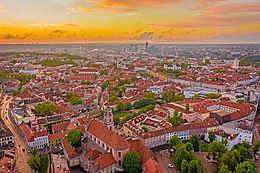
Vilnius is the capital of and largest city in Lithuania and the second-most-populous city in the Baltic states. The city's estimated July 2024 population was 605,270, and the Vilnius urban area has an estimated population of 708,627.
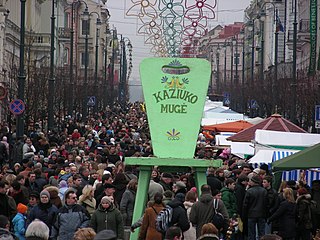
Kaziuko mugė or Saint Casimir's Fair is a large annual folk arts and crafts fair in Lithuania, dating to the beginning of the 17th century. The fair is traditionally held in city's markets and streets on the Sunday nearest to 4 March, the anniversary of Saint Casimir's death. In Lithuanian, Kaziukas is a diminutive of Casimir. Today, Saint Casimir's fair also features music, dance, theater performances; it attracts tens of thousands of visitors and many craftsmen from across Lithuania as well as from neighbouring countries such as Latvia, Russia, and Poland. In recent years, the fair has expanded into other cities in Lithuania, Belarus, Poland.

Baroque architecture is a highly decorative and theatrical style which appeared in Italy in the late 16th century and gradually spread across Europe. It was originally introduced by the Catholic Church, particularly by the Jesuits, as a means to combat the Reformation and the Protestant church with a new architecture that inspired surprise and awe. It reached its peak in the High Baroque (1625–1675), when it was used in churches and palaces in Italy, Spain, Portugal, France, Bavaria and Austria. In the Late Baroque period (1675–1750), it reached as far as Russia, the Ottoman Empire and the Spanish and Portuguese colonies in Latin America. In about 1730, an even more elaborately decorative variant called Rococo appeared and flourished in Central Europe.

The Cathedral Basilica of St Stanislaus and St Ladislaus of Vilnius is the main Catholic cathedral in Lithuania. It is situated in Vilnius Old Town, just off Cathedral Square. Dedicated to the Christian saints Stanislaus and Ladislaus, the church is the heart of Catholic spiritual life in Lithuania.

The Catholic Church in Lithuania is part of the worldwide Catholic Church, under the spiritual leadership of the Pope in Rome. Lithuania is the world's northernmost Catholic majority country. Pope Pius XII gave Lithuania the title of "northernmost outpost of Catholicism in Europe" in 1939. The Vilnius Cathedral is the most important Catholic Church in Lithuania, which was previously used for the inauguration ceremonies of Lithuanian monarchs with Gediminas' Cap, while in modern times it is a venue for masses dedicated to the elected Presidents of Lithuania after their inauguration ceremonies and giving of oaths to the Nation in the Seimas Palace.

The Palace of the Grand Dukes of Lithuania is a palace in Vilnius, Lithuania. It was originally constructed in the 15th century for the rulers of the Grand Duchy of Lithuania and the future Kings of Poland. The palace, located in the lower castle of Vilnius, evolved over the years and prospered during the 16th and mid-17th centuries. For four centuries the palace was the political, administrative and cultural centre of the Polish–Lithuanian Commonwealth. It was demolished in 1801.
Marcin Knackfus, was an architect, professor, and military captain from the Polish–Lithuanian Commonwealth.

The Vilnius Castle Complex is a group of cultural, and historic structures on the left bank of the Neris River, near its confluence with the Vilnia River, in Vilnius, Lithuania. The buildings, which evolved between the 10th and 18th centuries, were one of Lithuania's major defensive structures.

The Cathedral of the Theotokos in Vilnius is the episcopal see of the Russian Orthodox Diocese of Lithuania.
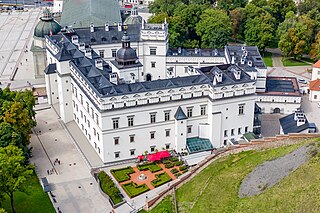
Lithuania attracts many visitors from neighbouring countries and from all over the world. In 2018,there were 1.7 million foreign visitors to Lithuania for business, family and leisure. The historical legacy of the Grand Duchy of Lithuania, its rich history, architecture, pristine nature, seaside and spa resorts are the main attraction points of Lithuania. Domestic tourism is also highly popular: in 2018 it grew by 12%. Lithuanians also prefer to spend their vacations in Lithuania – 70 percent.
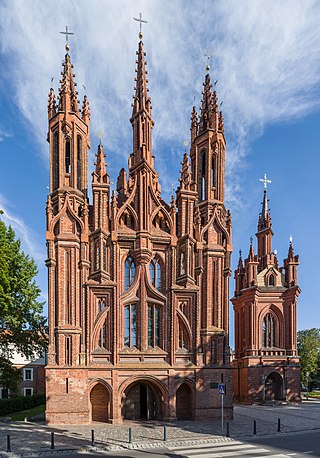
St. Anne's Church is a Roman Catholic church in Vilnius' Old Town, on the right bank of the Vilnia river established circa 1495–1500. It is a prominent example of both Flamboyant and Brick Gothic styles. St. Anne's is a prominent landmark in the Vilnius Old Town that enabled the district to be named as a UNESCO World Heritage Site, and is one of the most interesting examples of Gothic architecture in Lithuania.
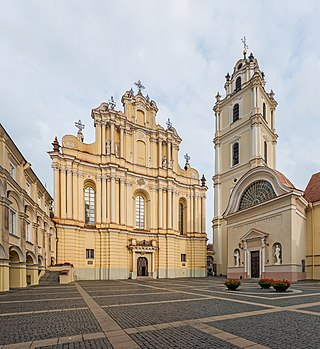
Johann Christoph Glaubitz was an architect of German descent who is generally considered to be the most prominent Baroque architect in the lands of the former Grand Duchy of Lithuania.

The architecture of Poland includes modern and historical monuments of architectural and historical importance.
The following is a timeline of the history of the city of Vilnius, Lithuania.

Tiškevičiai Palace is a former residential palace in Vilnius Old Town, near the intersection of Trakų and Pylimo streets.

The Church of St. Casimir is a Roman Catholic church in Vilnius' Old Town, close to the Vilnius' Town Hall. It is the first and the oldest baroque church in Vilnius, built in 1618.

The Orthodox Church of the Holy Spirit is a Russian Orthodox church in the Vilnius Old Town, capital of Lithuania, rebuilt 1749–1753 in the Vilnian Baroque style. The monastery serves as the headquarters of the Russian Orthodox Diocese of Lithuania. It should not be confused with the Roman Catholic Church of the Holy Spirit in Vilnius.
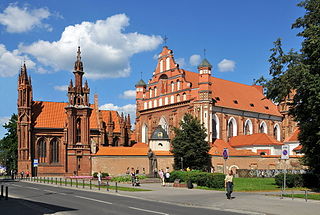
Lithuania is not the very centre of Gothic architecture, but it provides a number of examples, partly very different and some quite unique.

The architecture of Belarus spans a variety of historical periods and styles and reflects the complex history, geography, religion and identity of the country. Several buildings in Belarus have been designated as UNESCO World Heritage Sites in recognition of their cultural heritage, and others have been placed on the tentative list.

The Vilnian Baroque or the School of Vilnius Baroque is a name of late Baroque architecture style in Catholic church architecture of the Grand Duchy of Lithuania, which expanded well into Greek Catholic church architecture on territories covered by the Union of Brest. The style was formed by alumnus of the Catholic Jesuits' Vilnius University. Most preserved buildings in this style are in Vilnius.
